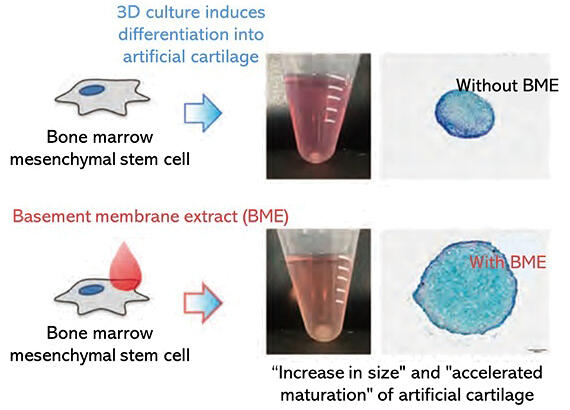Cartilage is an essential tissue for bone and marrow development. The bones of the limbs, such as the femur, undergo "endochondral ossification," in which cartilage tissue is replaced by bone tissue, leading to bone and marrow formation. The reproduction of endochondral ossification using "organoids," i.e., artificial organs produced in cell culture, can be used as a tool for research on skeletal and bone marrow development and regeneration. However, this required a stem cell-based artificial cartilage organoid that possesses an endochondral ossification phenotype.
A research group led by Graduate Student Hinako Notoh and Associate Professor Shogo Tamura of the Graduate School of Health Sciences at Hokkaido University improved the conventional method of producing cartilage organoids by developing a technique to mix in "basement membrane extract (BME)," which is a thin membrane between the epithelium and connective tissue of the skin. They evaluated the characteristics of endochondral ossification using this method.
After 21 days in culture, cartilage organoids admixed with BME grew in size and developed cartilage characteristics at an earlier stage compared to those that did not contain it. On day 7 of differentiation induction, the chondrogenic differentiation signal was enhanced. On day 21, in addition to chondrogenic differentiation, the expression of genes related to skeletal differentiation and ossification was enhanced, indicating the successful production of cartilage organoids with higher tissue maturity than before.
The development of stem cell-based models of endochondral bone formation will provide insights into the mechanisms of cartilage, bone, and bone marrow formation and the diseases associated with these tissues. Although the BME used in this research was derived from mice, the group plans to develop a drug containing only human-derived components and develop it as a regenerative medicine material for clinical application.





